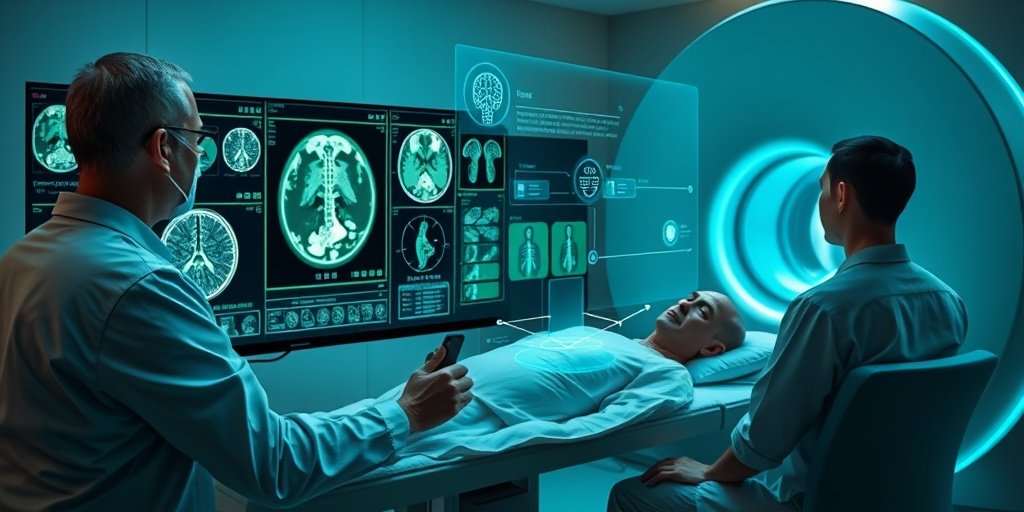⚡ Quick Summary
This comprehensive review highlights the significance of multi-modal medical image fusion (MMIF) in enhancing diagnostic accuracy by integrating data from various imaging modalities such as X-ray, MRI, and CT. The study emphasizes the role of deep learning and generative models in advancing MMIF techniques, ultimately improving patient-specific therapeutic outcomes.
🔍 Key Details
- 📊 Focus: Multi-modal medical image fusion (MMIF)
- 🧩 Modalities integrated: X-ray, MRI, CT, PET, SPECT, Ultrasound
- ⚙️ Technologies discussed: Traditional fusion methods, deep learning, generative models, transformer-based architectures
- 🏆 Applications: Oncology, neurology, cardiology
🔑 Key Takeaways
- 📈 MMIF enhances diagnostic precision by combining multiple imaging modalities.
- 💡 Deep learning has revolutionized MMIF, improving robustness and computational efficiency.
- 🏥 Clinical applications span across various fields, significantly impacting precision medicine.
- 🔍 Challenges include data privacy, computational complexity, and integration into clinical workflows.
- 🌟 Future research should focus on explainable AI and real-time fusion systems.
- 📚 A GitHub repository is available for researchers, containing datasets and models for further exploration.

📚 Background
The integration of multiple imaging modalities has become a cornerstone in modern diagnostics, allowing for a more comprehensive view of patient anatomy and pathology. Multi-modal medical image fusion (MMIF) is increasingly recognized as a vital technique that enhances diagnostic precision and supports effective clinical decision-making. By combining data from various sources, MMIF provides clinicians with detailed images that significantly improve lesion detection and segmentation.
🗒️ Study
This review meticulously surveys the evolution of MMIF, examining traditional fusion approaches such as pixel-, feature-, and decision-level methods. It also explores recent advancements driven by deep learning and transformer-based architectures, providing a critical comparative analysis of these methodologies. The study highlights the importance of MMIF in clinical applications across oncology, neurology, and cardiology, showcasing its role in precision medicine.
📈 Results
The review reveals that contemporary MMIF techniques, particularly those utilizing deep learning, exhibit superior robustness and computational efficiency compared to traditional methods. These advancements have led to significant improvements in diagnostic accuracy and patient-specific therapeutic outcomes, underscoring the transformative potential of MMIF in clinical settings.
🌍 Impact and Implications
The implications of this review are profound, as MMIF stands to revolutionize diagnostic practices across various medical fields. By enhancing the precision of imaging and facilitating better clinical decision-making, MMIF contributes to improved patient outcomes and personalized healthcare. The integration of advanced technologies like explainable AI and privacy-preserving federated learning frameworks will further enhance the adoption of MMIF in routine clinical use.
🔮 Conclusion
This comprehensive review highlights the incredible potential of multi-modal medical image fusion in transforming diagnostic practices. As we continue to explore the integration of advanced technologies, the future of MMIF looks promising, paving the way for enhanced patient care and personalized healthcare solutions. Continued research and development in this field are essential for overcoming existing challenges and maximizing the benefits of MMIF.
💬 Your comments
What are your thoughts on the advancements in multi-modal medical image fusion? We invite you to share your insights and engage in a discussion! 💬 Leave your comments below or connect with us on social media:
A comprehensive review of techniques, algorithms, advancements, challenges, and clinical applications of multi-modal medical image fusion for improved diagnosis.
Abstract
Multi-modal medical image fusion (MMIF) is increasingly recognized as an essential technique for enhancing diagnostic precision and facilitating effective clinical decision-making within computer-aided diagnosis systems. MMIF combines data from X-ray, MRI, CT, PET, SPECT, and ultrasound to create detailed, clinically useful images of patient anatomy and pathology. These integrated representations significantly advance diagnostic accuracy, lesion detection, and segmentation. This comprehensive review meticulously surveys the evolution, methodologies, algorithms, current advancements, and clinical applications of MMIF. We present a critical comparative analysis of traditional fusion approaches, including pixel-, feature-, and decision-level methods, and delves into recent advancements driven by deep learning, generative models, and transformer-based architectures. A critical comparative analysis is presented between these conventional methods and contemporary techniques, highlighting differences in robustness, computational efficiency, and interpretability. The article addresses extensive clinical applications across oncology, neurology, and cardiology, demonstrating MMIF’s vital role in precision medicine through improved patient-specific therapeutic outcomes. Moreover, the review thoroughly investigates the persistent challenges affecting MMIF’s broad adoption, including issues related to data privacy, heterogeneity, computational complexity, interpretability of AI-driven algorithms, and integration within clinical workflows. It also identifies significant future research avenues, such as the integration of explainable AI, adoption of privacy-preserving federated learning frameworks, development of real-time fusion systems, and standardization efforts for regulatory compliance. This review organizes key knowledge, outlines challenges, and highlights opportunities, guiding researchers, clinicians, and developers in advancing MMIF for routine clinical use and promoting personalized healthcare. To support further research, we provide a GitHub repository that includes popular multi-modal medical imaging datasets along with recent models in our shared GitHub repository.
Author: [‘Zubair M’, ‘Hussain M’, ‘Albashrawi MA’, ‘Bendechache M’, ‘Owais M’]
Journal: Comput Methods Programs Biomed
Citation: Zubair M, et al. A comprehensive review of techniques, algorithms, advancements, challenges, and clinical applications of multi-modal medical image fusion for improved diagnosis. A comprehensive review of techniques, algorithms, advancements, challenges, and clinical applications of multi-modal medical image fusion for improved diagnosis. 2025; 272:109014. doi: 10.1016/j.cmpb.2025.109014